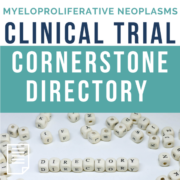Factors That Affect Waldenström Macroglobulinemia Treatment Decisions
Factors That Affect Waldenström Macroglobulinemia Treatment Decisions from Patient Empowerment Network on Vimeo.
Many factors come into play when making treatment decisions for Waldenström macroglobulinemia (WM) patients. Dr. Jorge Castillo reviews key decision-making factors and explains how genomic profiling results may affect WM care.
Dr. Jorge Castillo is Clinical Director at the Bing Center for Waldenström Macroglobulinemia Dana-Farber Cancer Institute and Assistant Professor of Medicine at Harvard Medical School. Learn more about Dr. Castillo, here.
See More From The Pro-Active Waldenström Macroglobulinemia Patient Toolkit
Related Programs:

|

|

Why Patients Should Speak Up About WM Symptoms and Side Effects |
Transcript:
Katherine:
Dr. Castillo, many factors coming into play, obviously, when making a treatment decision. How do you decide which treatment is appropriate for a particular patient?
Dr. Castillo:
Yeah, that’s a million-dollar question. And the reason that is the case is because when we think about other types of cancers, right, breast cancer and lung cancer, we do have these large studies with thousands of patients in which half of the group got one treatment; the other half got the other treatment. And we know that one treatment is better than other in this context of a randomized, large study. We don’t have a lot of that in Waldenstrom’s because it’s a rare disease. So, most of the studies that we do have are studies in which we have maybe 30, 40, 50 patients, 100 if we’re lucky, so comparisons between all these different treatments have not been done.
So, the chemotherapy, for example, versus the PI, there’s no study comparing that. The chemotherapy versus the BTK inhibitors, there’s no study comparing that. So, based on that, since there’s no comparison, we need to kind of understand the profile of the drug, you know. And you need to match that with the patient’s preferences.
So, we need to look at the patient’s age. We need to look at the patient’s comorbidities. We need to look at the patient’s medications that they’re on. Are their insurance going to cover the pills or not? Are they comfortable with getting intravenous infusions? What is the risk of leukemia versus the risk of neuropathy in those patients? So, we need to look at so many
factors. Interestingly enough, efficacy is not the problem. We don’t choose treatments based on efficacy because all of the treatments are almost equally effective. We actually choose treatments based on patients’ preferences. We choose treatment based on the medication side effects.
And the newer thing is actually, we’re doing genomic profile in the patients. We’re actually seeing which mutations the patients have, and there are some treatments that work better or worse with specific mutations, so we kind of tailor a treatment option based on all those factors.
So, it’s not an easy job, but I think it’s rewarding to understand that the best treatment for a patient with Waldenstrom’s is a personalized treatment. And as long as –
Katherine:
That’s what it sounds like.
Dr. Castillo:
And as long as the patient understands the best he or she can in terms of the pros and cons of the treatment before going in, an educated decision, I think that’s probably best choice, yeah.
Katherine:
Are there test results that can impact options?
Dr. Castillo:
I would say so. So, for example, in patients who have very high IgM levels, we try to avoid giving rituximab alone, for example, because rituximab can also make the IgM go up in about 40 to 50 percent of the cases, and patients can become more symptomatic if they were symptomatic because of the IgM in the first place.
So, that’s one value that we follow carefully. Sometimes, the kidney function can tell us if there are some chemotherapies that cannot be given with a kidney function that is not normal or close to normal, for example. And again, there are some mutations that can help us understand if a treatment might work better than other treatments too.
So, yeah, there’s a lot of shades of gray in there to be able to pick and choose. And again, the patient’s symptoms are important. I mean, if a patient, for example, already has an arrhythmia, I’m going to try to avoid a medication that can cause more arrhythmias. If a patient has already some nerve damage, I’m less likely to recommend a treatment that can cause more nerve damage. So, yeah, there’s a lot of room there for personalization.
Katherine:
Yeah. You’ve mentioned existing conditions. So, how do patients’ specific factors like lifestyle and age and other preexisting conditions impact treatment choices?
Dr. Castillo:
Well, I think the way that affects it is just because patients who are older age tend to have other problems, you know. And I think having that in mind is important. So, if somebody has a liver dysfunction of some kind, then that will modify my treatment options. And as I said earlier, if someone has a kidney disfunction of some kind or depending on the degree, I can choose a different type of treatment there.
Now, also, we need to be mindful, for example, if somebody’s not so reliable on taking pills because they cannot remember or they don’t know, they are not organized enough or they don’t – you know. So, there are so many other factors playing into that role – maybe a pill form treatment might not be the best option, you know.
If somebody doesn’t have help to transfer him to take him to the infusion room back and forth, maybe an infusion treatment might not be the best there. So, again, another series of factors could be taken into account when making treatment decisions.










